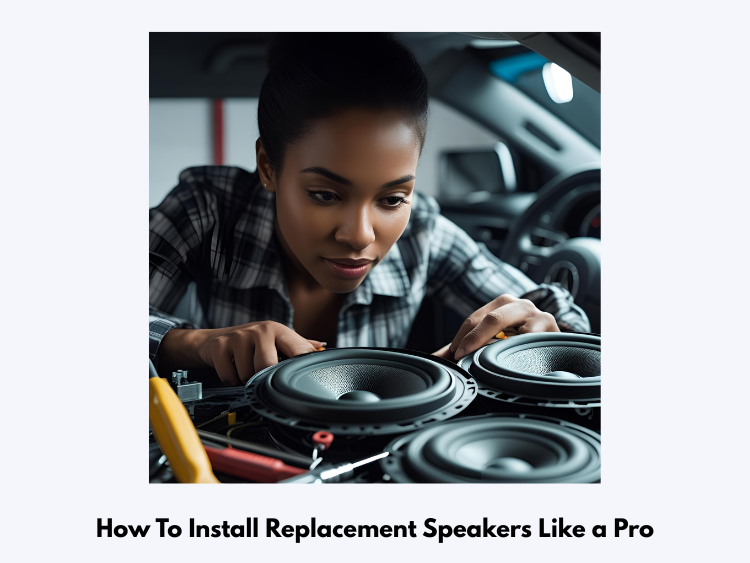Replacing old speakers can make your music sound much better, whether it’s in your car or at home. It might seem like a job for a pro, but with the right tools and a little know-how, you can do it yourself. This article will guide you through the key steps so you can install new speakers with ease and confidence.
Why Should You Get New Speakers?
First, let’s talk about why we want to do this. Factory-installed speakers often lose their quality over time. It is possible for sound to get blocked, altered, or weakened. Getting new ones can:
- Better sound quality and bass reaction
- Allow extra music equipment to have more power
- If your speakers are buzzing, popping, or dead
If you’re replacing worn-out units, be sure to check out some of the best replacement speakers for home audio in 2025 or top car replacement speakers for superior sound before making a purchase.
Materials and Tools You’ll Need
Get the right tools to begin. Here’s what you’ll need to install most speakers:
- New speakers that are the right size and power
- Drivers for screws (Phillips and flathead)
- A tool to remove or cut panels
- How to strip and crimp wires
- Sticky tape or a soldering kit
- A set of mounting clamps or adapters
- Foam blocks or insulation (not required, but a good idea
When working on a car, it’s also helpful to have a repair instruction that is specific to that make and model.
A Step-by-Step Guide on How to Change Speakers
Step 1: Take Out the Old Speakers
- Turn off the power: To avoid electrical sparks when installing the battery in a car, take off the negative wire.
- Get to the speakers: This process is different based on where it’s done:
- Car door: Unscrew and unclip the door panel to take it off. Damage can be avoided with a cut tool.
- Home audio systems: Take off the speaker cover or remove the casing.
- Car door: Unscrew and unclip the door panel to take it off. Damage can be avoided with a cut tool.
- Disconnect the old speaker: Carefully remove the wire harness or spade plugs from the speaker and unscrew it from the mount.
Step 2: Look Over the Speaker Wiring
- Check the wires for damage or rust before putting in the new speaker.
- Remove the ragged or weak wires and reattach them with new wire plugs or solder.
- Use crimp connectors, solder joints, or adapter wires if the connectors on your new speaker don’t match the ones on the old one.
Step 3: Make Sure the Speaker’s Size and Power Match
Use an adapter bracket or make sure that the new speaker fits the mount that is already there. Look at these parameters:
- Size of the speaker (in inches, like 6.5″)
- Depth of mounting (important for doors that don’t fit easily)
- Impedance (measured in ohms) — meeting this prevents damage
- Power handling (equal to or greater than the power of your amplifier)
Putting in a speaker that doesn’t meet these requirements could hurt the sound or even break your system. If you’re unsure about woofer compatibility, check this comparison: Which do you need – a woofer or a subwoofer?
Step 4: Put the New Speaker in Place
- Make sure the polarity is right when you connect the speaker lines to the new unit (positive to positive, negative to negative).
- A lot of speakers have labels on the connections, or you can use the color codes:
- Black or striped lines in cars are ground (negative).
- Solid-colored lines are positive.
- Black or striped lines in cars are ground (negative).
- Once it’s hooked, use the original screws or the ones that come with the speaker to place it.
- To cut down on vibrations and improve sound quality, put the foam plugs behind the speaker.
Step 5: Put the System to the Test
- Run a test on the speaker before putting the panel or case back together completely.
- Turn on the sound system and set the volume low.
- Check for noise, distortion, or quiet.
- If there is no sound or only a weak sound, check the wires and orientation again.
- Put back on any panels, grilles, or caps when you’re done.
Conclusion
Getting new speakers isn’t just a fix; it makes your sound better overall. You can do it yourself and get results that look like they were done by a pro if you are patient and have the right tools. If you follow these steps, you’ll get clear, powerful sound for years to come, whether you’re putting in coaxial speakers in a car or replacing bookshelf speakers in your home theater.




